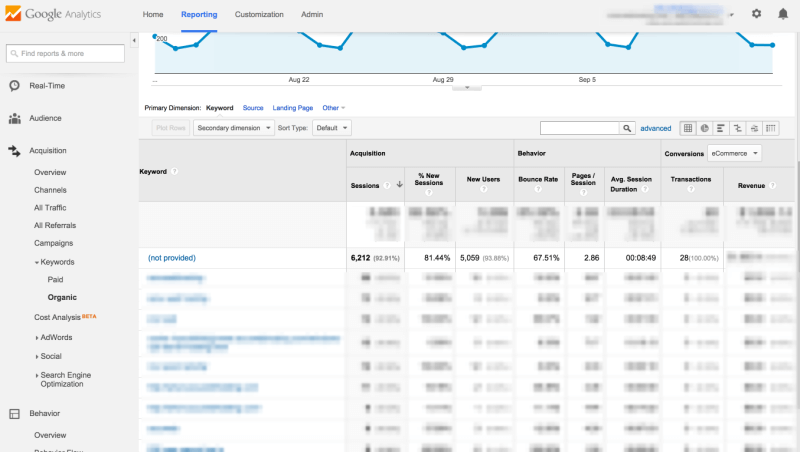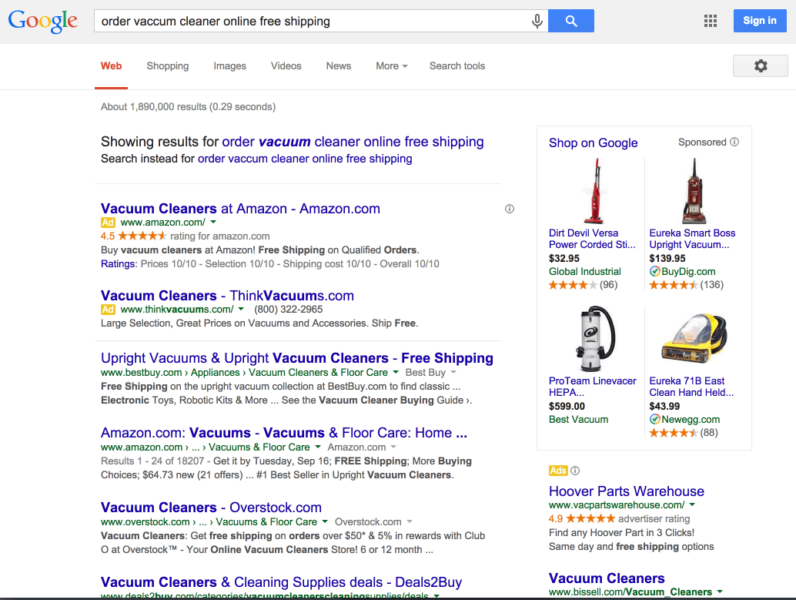How To Dissect Your Organic Traffic By Intent & Funnel It Into Sales
Columnist Neil Patel reminds us it's not the search query itself, but the intent behind it that is important to divine, if we marketers are to effectively drive conversions
Numbers alone don’t tell the whole story of who’s visiting your website. In order to accurately understand who users are, what they’re doing, and what they want, you have to go a step further.
You must understand the user’s intent and act on that information. Obviously, intent is a lot more “fuzzy” and a lot less quantifiable than the crisp, exact numbers that you see in Google Analytics.
How can you understand the intent behind the organic traffic on your website? And what kind of action can you take on this information?
Every Searcher Has An Intent
If there’s one fact that’s crucial to this entire article, it’s this: Every user has an intent.
Put another way, there’s no such thing as people typing in random queries without a reason for typing in those queries. A searcher must have intent.
The user’s intent should dictate everything about their subsequent experience. Here’s how it works:
- Action: A user, with an intent, types in a query.
- Response: The user receives a search engine results page (SERP) listing websites that align with his or her intent.
Let me show you this example again, and plug in a real life example.
- Action: A user wants to purchase a black Gucci men’s wallet. He types the query [buy black gucci men’s wallet] into a search box.
- Response: The user receives a SERP that presents him with several good options to buy black Gucci men’s wallets.
Here’s what he sees after typing in his query:
Because every search has intent, you can safely assume that every one of the searches that lands on your site is backed by some intent.
In the user’s mind, his intent is the most important thing about his entire searching effort. He is not as interested in the specific keywords he’s using as he is in the overall intention behind those keywords.
We as search engine optimizers and marketers need to understand this. Failure to understand a user’s intent can lead to a huge loss of click-through traffic, dwell time, and conversions.
Conversion optimization consultant Jeremy Smith illustrated this well in a piece he wrote last year on common landing page issues. He searched on the phrase [iphone cases], and one of the landing pages returned by this search, rather than featuring iPhone cases, showed tablet cases and cases for other types of phones. “By failing to adapt to my search intent, they are minimizing their likelihood of my conversion,” he wrote.
Our job as search marketers is to figure out that intent and respond accordingly.
There Are Three Major Categories Of User Intent
In his excellent article way back in 2007, MOZ founder Rand Fishkin provided a clear overview of the main types of search queries, which are differentiated by searcher intent. The three major ones are as follows:
- Navigational queries occur when the searchers are looking to navigate to a specific website. An example might be someone searching for [facebook] or [new york times].
- Informational queries occur when searchers are looking for answers to questions or information about a specific topic. An example might be someone searching for [movies starring sylvester stallone] or [how many teaspoons in a tablespoon].
- Transactional queries occur when searchers are looking to perform some sort of conversion action, such as buying a product, finding a local business, signing up for a service, etc. An example might be someone searching for [buy black gucci men’s wallet] or [renew car registration online].
(Note: Rand had a fourth category, which he dubbed “commercial investigation.” However, since this has so much overlap with both “informational” and “transactional,” most SEOs today usually talk about three major types of intent.)
Thus, there are three main categories of intent: navigational, informational, and transactional. But merely knowing this factoid does little to advance our SEO strategy. We need to understand how to apply that knowledge to the actual queries that searchers are using to find our site.
How Do You Discover Intent? Queries.
Two years ago, search expert Grant Simmons wrote this inflammatory headline: “Keywords Are Dead! Long Live User Intent!”
His point is that keywords can’t reveal intent. Only queries can do that.
As SEOs, we must hone in on the intent behind the query. Here is a simple process of using queries to discover user intent.
Create A List Of Queries
The first step is to understand what queries users are inputting to find your site. There are several ways you can do this:
Google Webmaster Tools. Access your site’s Google Webmaster Tools account, and navigate to Search Traffic → Search Queries. Although it is simplified, you can view some of the queries that people are using to find your site.
Google Analytics. Another way of uncovering the source of organic traffic is to use Google Analytics. Although keyword data is limited due to Google’s switch to secure search back in 2013, you can still use landing page reports, look at traffic sources, and examine AdWords data to get a good sense of the keywords and queries that searchers are using to find your site.
Keyword research. Your customary keyword research is also a valuable source of uncovering intent-related query data. Using less-than-obvious sources for keyword research is a powerful way to uncover queries that will improve your game.
Using these sources (and any others that you prefer), create a master list of queries. This is your working dataset for the steps that follow.
Match Each Query To The User’s Potential Intent
Once you have a list of queries, you’re ready to gain a deeper understanding of the intent of the user. I suggest a two-step approach to doing this. First, match the query to a broad user intent, and then narrow that intent down even further.
Categorizing By Broad User Intent
This first step is the simplest one: Figure out what intent backs each query, and sort your list into navigational, informational, and transactional queries.
1. Navigational. A lot of your queries will be navigational. These are the easiest to identify, because they will probably contain your brand name or some variation of it.
2. Informational. Informational queries typically have the most words. These contain no branding, but will almost always contain some of your target keywords.
3. Transactional. These queries are also easy to identify. They contain conversion-related words such as “buy,” “order,” “purchase,” “coupon,” “deal,” etc. The queries are created in such a way that they indicate the user’s preparedness to convert and/or purchase.
Narrowing Down User Intent
Once you’ve gotten things categorized broadly, it’s time to get granular.
As awesome as it feels to categorize a bunch of queries, this doesn’t go very far in addressing the user’s intent. Remember, searchers are often looking for something fairly specific. (See the “iPhone case” example above.)
While it would be impossible for me to create a list of these narrower types of intent (because so much depends on your specific niche/website), I can provide some examples that will hopefully give you a solid understanding of what I mean.
More Specific Navigational Queries
Each of these variations on the navigational search intent help inform a more precise type of intent. Not only are users looking for your site, but they are looking for particular features or types of information on your site.
Hybrid Search. Many times, searchers will combine navigational searches with informational searches. If they know your brand as an established authority in a niche, then they may be looking for information (informational intent) that your brand has produced (navigational). For example, someone searching for “user persona hubspot” is combining two types of searches, probably looking specifically for HubSpot’s guide to creating user personas.
Well-Known Features. If your brand is known for a certain product, then users may remember the product, but not remember your specific brand. Navigational searches would obviously return the brand. That’s their intent. But since they can’t remember your brand, they will type in a well-known feature of your brand. For example, I find that many searchers are looking for “advanced guide to content marketing.”
Clearly, Google is delivering navigational-style results; they assume that users are headed towards Quicksprout.
Personal Names. If you are well-known in your niche, then users may be searching for your personal brand — your name — instead of your actual business name.
More Specific Informational Queries
Informational searches will typically represent your largest and most diverse category. Depending on the breadth and quality of your content, you could be facing tens of thousands of different informational queries. It’s important to study the variation of these informational queries so you can best adapt to user intent.
Combinations. Users sometimes search for many types of information within a single query. If users are searching for a combination of different pieces of information, you can potentially create a highly targeted informational article for this intent.
Take this query, for example: “using seo techniques in content marketing for ecommerce.” A page that produces this combination of information will get the traffic.
Problems. Consider carefully the problem that backs potential queries. Some of these are obvious, such as “getting rid of ant infestation.” Clearly, the user has a problem with ants. Your goal in serving the user’s intent is to help them solve that problem.
Types Of Solutions. Along with the actual problem, many users reveal their desired solution. For example, in the query [getting rid of ant infestation], some users may be even more specific:
- getting rid of ant infestation diy
- common kitchen solutions to get rid of ant infestation
- getting rid of ant infestation in summer
Understanding the user’s type of solution will help you to create highly targeted type of information.
One of the most common types of informational queries is the “how to.” If a user is searching for “how to,” you have an immediate clue as to their intent.
More Specific Transactional Queries
In the broad realm of transactional queries, you’ll see a lot of variation. Look for the following clues as to intent:
Product-Specific Intent. What type of product or service is the customer looking for? This could be different size (men’s t-shirt xxl), gender (women’s cardigan), color (blue socks), type (case for macbook pro 13”), and usage (outdoor wet/dry vac).
Price Intent. When users affix price qualifiers to their query, you have instant information on what’s going to make them interested. It’s all about the price and/or perks. Examples: “discount handbags,” “deals on cars,” “lowest price airfare,” “coupons for bulk coffee,” etc.
Delivery Intent. The world of e-commerce is characterized by delivery perks, speedy delivery, and other delivery options. Delivery-specific transactional queries may look like this: “Two-day shipping for vacuum,” “free shipping bulk clothing,” “insured shipping for diamond engagement ring,” etc.
Location Intent. If you run a brick-and-mortar that is depending upon local customers, you’ll need to target local users who are searching for products or services in your specific city or neighborhood.
Funneling Traffic Into Sales
All of this intent categorization effort is focused on a single goal: funneling this traffic into sales. How are you going to do this? If you’ve gone to all the work of segmenting organic traffic by intent, it shouldn’t be that hard. There are four main steps:
1. Create Relevant Content. First, you need to have the right stock of content. Allow the intent behind these queries to influence your content marketing efforts. You know the user’s intent. Now, satisfy it with the most relevant content possible.
Creating relevant content includes making a lot of content. You should create both information-rich pages that contain relevant informational longtail queries, and more product-focused pages that will appeal to transactional users.
The more content you have on the more pages, the more effective you’ll be at appealing to the various classes of users that are searching for each type of content.
2. Use The Right Keywords & SEO Data. Be at the top of your SEO game. Knowing a user’s intent doesn’t mean that you can ignore the basics of SEO. Use the right longtail keywords in your content. Optimize your titles. Hold your H1s high. Use SEO best practices as you create pages and content.
This is not an advanced concept. However, it is nonetheless essential. Here’s how the SEO basics play into a sales-funnel:
- Page title: User sees a title that has keywords that match his or her intent.
- Meta description: User is drawn in by a meta description that speaks exactly to his or her need.
- H1: The user clicks through to the page, and sees a page title that matches his or her intent, confirming that they are in the right place.
Result: With effective copy, the user will convert. The needs and desires of the traffic have been met. This is how the traffic is funneled into sales.
3. Focus On User Experience. The most important step in this entire process is to optimize the user’s experience. Remember, this is about the user’s intent. Give them the most meaningful experience based on this intent.
You already know what the user wants when they visit your page. Therefore, everything you design and develop should deliver on that intention. The only way you’ll be able to funnel intention into sales is by addressing that intention in the user experience.
4. Put Calls-To-Action Everywhere. You won’t be able to funnel anything into sales without a call-to-action (CTA). This is basic conversion optimization. Strategically place CTAs throughout your content. Match these CTAs with the intent of the user.
Conclusion
We’ve reached a point in content marketing and SEO where it’s no longer enough to focus on keywords and create optimized content. Today, it’s important to understand the intent behind keywords and queries. As marketers, we need to meet that intent.
When we understand that intent, and answer it, we can’t help but experience a higher volume of sales.
How do you identify user intent and funnel it into sales?
Opinions expressed in this article are those of the guest author and not necessarily Search Engine Land. Staff authors are listed here.
Related stories
New on Search Engine Land








